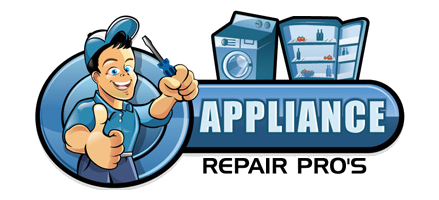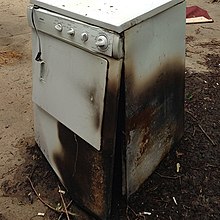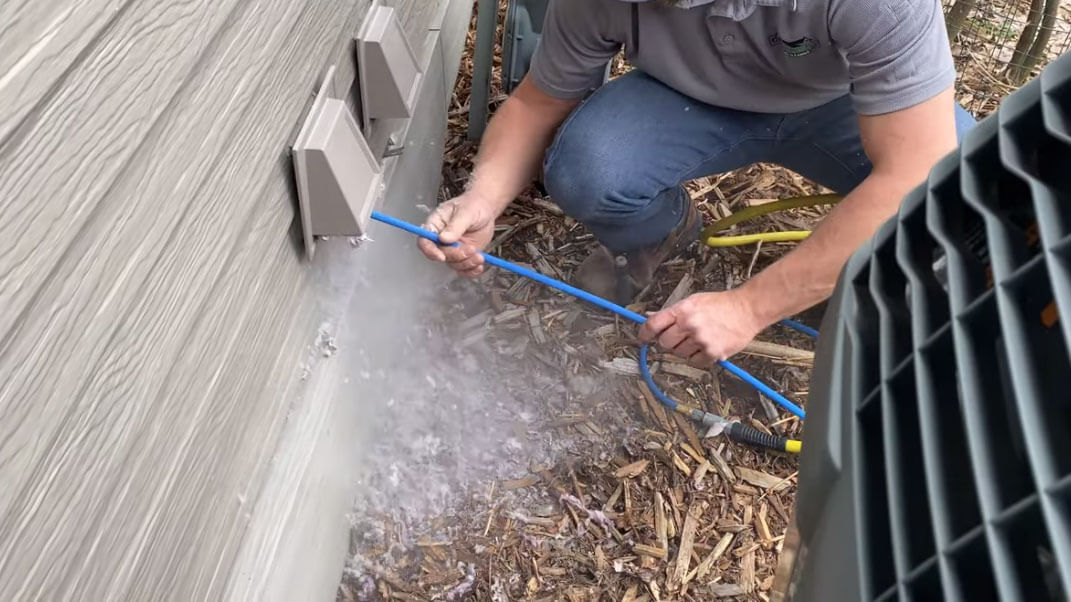
Professional Dryer Vent Cleaning in Port St Lucie, FL (772) 501-9870
Dryer Vent Cleaning is important especially in Port St Lucie, FL because most of the homes here are roof vented with pest protection around the vent exhaust. These create the ideal scenario for vents to become neglected and clogged over the years.
Dryer Vents Should Be Cleared From The Exhaust & Inside The Home
Dryer vent cleaning is more often than not overlooked until its to late. The Appliance Manufacturers have implemented hi-limit and thermal cut out thermostats as well as thermal fuses internally to prevent a fire. When these devices fail it is a tell tale sign of airflow problems. As a part of our service we clean inside the dryer and eliminate lint buildups around the heating element that can cause combustion.
-
We use a rotary brush and simultaneous vacuum to completely clean the encrusted lint build-up in the dryer vent, down to the smooth bare metal
-
We utilize a scope camera to show you live video of the inside of the vent from floor to roof outlet, before and after the rotary brush dryer vent cleaning. Leaving you with the peace of mind you and your family deserve.
-
We completely clean the dryer vent from floor to roof outlet, as well as ensure the backdraft damper flap is working properly, regardless of whether you have a one or two story home
-
As a family owned/operated, local business, we have one set fee with NO hidden fees. See PRICING page for fixed fees in your area.
We provide outstanding service, fast turn arounds, and affordable pricing. Our technicians and service people have many years of experience servicing Dryers. Our Dryer repair team is extremely qualified and can handle the most technical Dryer repair jobs.
Contact us today and see the difference!
Dryer repair is a very sensitive task involving electrical connections, and electronic control parts. Your Dryer should always be repaired by a qualified technician. The simplest things can make a Dryer unrepairable. We can fix most mistakes made by others, although there's the chance that negligence can destroy a Dryer.
Contact a Dryer Repair Specialist (772) 501-9870
A clothes dryer, also known as tumble dryer, is a powered household appliance that is used to remove moisture from a load of clothing, bedding and other textiles, usually shortly after they are washed in a washing machine. Otherwise, clothes may also be dried by natural evaporation and, if available, sunlight, on an outdoor or indoor clothes line or clothes horse.
Many dryers consist of a rotating drum called a "tumbler" through which heated air is circulated to evaporate the moisture, while the tumbler is rotated to maintain air space between the articles. Using these machines may cause clothes to shrink or become less soft (due to loss of short soft fibers/lint). A simpler non-rotating machine called a "drying cabinet" may be used for delicate fabrics and other items not suitable for a tumble dryer.
Drying at a minimum of 60°C (140°F) heat for thirty minutes kills many parasites including house dust mites,[1] bedbugs[2] and scabies mites[3] and their eggs. Simply washing drowns dust mites and exposure to direct sunlight for three hours kills their eggs.[4]
Combination washer-dryers perform both functions in one device.
Others include steam to de-shrink clothes and avoid ironing.[5]
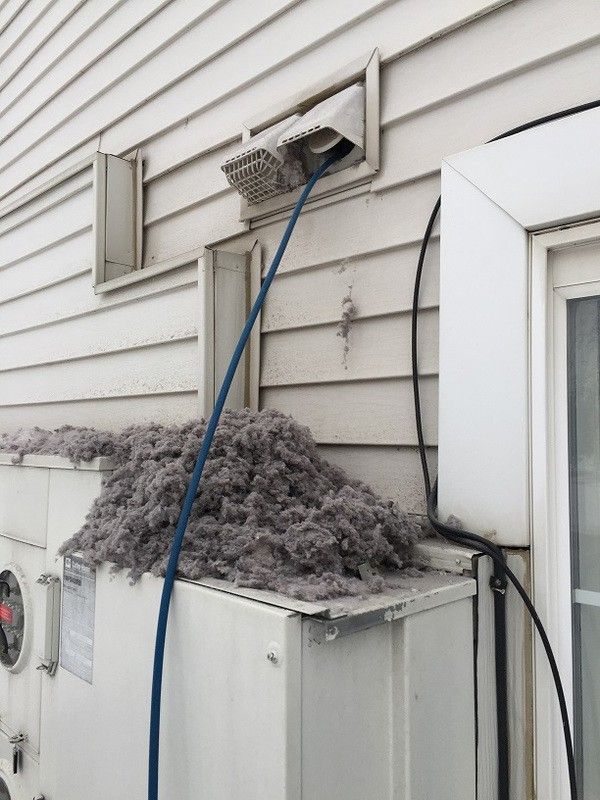
- Whirlpool
- GE General Electric
- Frigidaire
- Electrolux
- Maytag
- Kitchenaid
- Jenn Aire
- Sub Zero
- Wolf
- Thermador
- Kenmore
- Sears
- Samsung
- LG
- Amana

Tumble dryers
Tumble dryers continuously draw in the ambient air around them and heat it before passing it through the tumbler. The resulting hot, humid air is usually vented outside to make room for more air to continue the drying process. This design makes no effort to recycle the heat put into the load, and thus is considered environmentally wasteful. Nevertheless, it is simple and reliable, and therefore has been widely used.
Improvised methods of salvaging this heat for in-home heating, by use of inline vent boxes equipped with a flapper valve to redirect moist heated air to indoor areas, will also increase humidity within a dwelling. Although this may be beneficial in dry winter conditions, excess humidity from these devices increases likelihood of mold, mildew, and bacterial growth inside a home. Indoor venting may also be against local regulations. Gas dryers, unlike electric dryers, must always be vented outdoors, as the products of combustion are mixed with the moist air. Building codes and manufacturers' instructions usually recommended that dryers vent outdoors. An indoor lint trap kit poses a similar concern of increased humidity within the dwelling.[further explanation needed]
"Long run" dryers have an additional fan inside to boost the exiting moist air through longer sections of vent pipe, as in apartments or dwellings where the vent cannot make a short direct connection from the dryer to the outside.
Beyond issues with venting exhaust, other improvised efficiency efforts with conventional dryers attempt to harvest an input source of pre-heated air rather than using the conditioned air of the living space. One notable source of heat to pre-heat dryer air is to install ductwork allowing the device to suck hot air from a dwelling's attic.[citation needed]
Tumble dryers are often integrated with a Washing machine, in the form of laundry centers, which stacks the dryer on top of the washer and integrates the controls for both machines in a single control panel, or in the form of "washer-dryer combos" which are essentially a front loading washing machine with an integrated dryer. Often the washer and dryer functions will have a different capacity, with the dryer usually having a lower capacity than the washer. Tumble dryers can also be top loading, in which the drum is loaded from the top of the machine and the drum's ends are in the left and right sides, instead of the more conventional front and rear. They can be as thin as 40cm in width.
Lint build-up (tumble dryers)
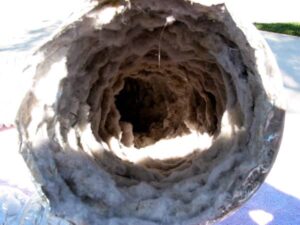
Upper image shows a severely kinked and blocked dryer transition hose used to vent a tumble dryer. In this case, the dryer was located or pushed back too far against the wall. The lower image shows initial lint build-up in the flex transition hose.
Moisture and lint are byproducts of the tumble drying process and are pulled from the drum by a fan motor and then pushed through the remaining exhaust conduit to the exterior termination fitting. Typical exhaust conduit comprises flex transition hose found immediately behind the dryer, the 4-inch (100 mm) rigid galvanized pipe and elbow fittings found within the wall framing, and the vent duct hood found outside the house.
A clean, unobstructed dryer vent improves the safety and efficiency of the dryer. As the dryer duct pipe becomes partially obstructed and filled with lint, drying time increases and causes the dryer to overheat and waste energy. In extreme cases, a blocked vent may result in a fire. Clothes dryers are one of the more costly home appliances to operate.[16]
Several factors can contribute to or accelerate rapid lint build-up. These include long or restrictive ducts, bird or rodent nests in the termination, crushed or kinked flex transition hose, terminations with screen-like features, and condensation within the duct due to un-insulated ducts traveling through cold spaces, such as a crawl space or attic. If plastic flaps are at the outside end of the duct, one maybe able to flex, bend, and temporarily remove the plastic flaps, clean the inside surface of the flaps, clean the last foot or so of the duct, and reattach the plastic flaps. The plastic flaps keep insects and birds out of the dryer vent pipe. During cold weather, the warm wet air condenses on the plastic flaps, and minor trace amounts of lint sticks to the wet inside part of the plastic flaps at the outside of the building.[17],[18]
Ventless dryers include multi-stage lint filtration systems and some even include automatic evaporator and condenser cleaning functions that can run even while the dryer is running. The evaporator and condenser are usually cleaned with running water. These systems are necessary, in order to prevent lint from building up inside the dryer and evaporator and condenser coils.
Safety
Dryers expose flammable materials to heat. Underwriters Laboratories[19] recommends cleaning the lint filter after every cycle for safety and energy efficiency, provision of adequate ventilation, and cleaning of the duct at regular intervals.[20] UL also recommends that dryers not be used for glass fiber, rubber, foam or plastic items, or any item that has had a flammable substance spilled on it.
In the United States, the U.S. Fire Administration[21] in a 2012 report estimated that from 2008 to 2010, fire departments responded to an estimated 2,900 clothes dryer fires in residential buildings each year across the nation. These fires resulted in an annual average loss of 5 deaths, 100 injuries, and $35 million in property loss. The Fire Administration attributes “Failure to clean” (34%) as the leading factor contributing to clothes dryer fires in residential buildings, and observed that new home construction trends place clothes dryers and washing machines in more hazardous locations away from outside walls, such as in bedrooms, second-floor hallways, bathrooms, and kitchens.
To address the problem of clothes dryer fires, a fire suppression system can be used with sensors to detect the change in temperature when a blaze starts in a dryer drum. These sensors then activate a water vapor mechanism to put out the fire.[22]
Environmental impact
The environmental impact of clothes dryers is especially severe in the US and Canada, where over 80% of all homes have a clothes dryer. According to the US Environmental Protection Agency, if all residential clothes dryers sold in the U.S. were energy efficient, "the utility cost savings would grow to more than $1.5 billion each year and more than 22 billion pounds of annual greenhouse gas emissions would be prevented”.[23]
Clothes dryers are second only to refrigerators and freezers as the largest residential electrical energy consumers in America.[24]
In the European Union, the EU energy labeling system is applied to dryers; dryers are classified with a label from A+++ (best) to G (worst) according to the amount of energy used per kilogram of clothes (kWh/kg). Sensor dryers can automatically sense that clothes are dry and switch off. This means over-drying is not as frequent. Most of the European market sells sensor dryers now, and they are normally available in condenser and vented dryers.
